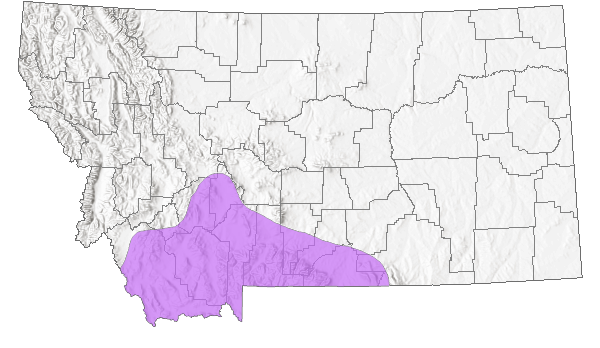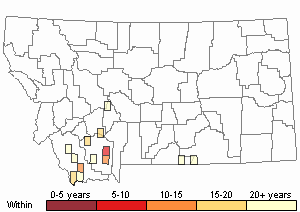View in other NatureServe Network Field Guides
NatureServe
Montana
Utah
Wyoming
Idaho
Wisconsin
British Columbia
South Carolina
Yukon
California
New York
Parry's Fleabane - Erigeron parryi
State Rank Reason (see State Rank above)
Though the species is restricted to southwest Montana, it is locally common at many of the sites it occupies. Additionally, threats to the species appear to be low as a result of the rocky, sparsely vegetated habitat it prefers.
- Details on Status Ranking and Review
Population Size
Score1 - Moderate: Generally 10,000-100,000 individuals.
Range Extent
Score3 - Local Endemic or Very Small Montana Range: Generally restricted to an area <10,000 sq. miles (equivalent to the combined area of Phillips and Valley Counties) or <6 Sub-basins (4th code watersheds) Range-wide OR limited to one Sub-basin in Montana
Area of Occupancy
Score2 - Low: Generally occurring in 4-10 Subwatersheds (6th Code HUC’s).
Environmental Specificity
Score1 - Moderate: Species is restricted to a specific habitat that is more widely distributed or to several restricted habitats and is typically dependent upon relatively unaltered, good-quality habitat (C Values of 5-7).
Trends
ScoreNA - Rank factor not assessed.
CommentTrends unknown though populations are likely stable or experiencing only minor declines.
Threats
Score0-1 - Low to Medium.
Intrinsic Vulnerability
Score0-1 - Low to Moderate Vulnerability.
Raw Conservation Status Score
Score
7 to 9 total points scored out of a possible 16 (Rarity factors and threats only).
General Description
Taprooted perennial with a simple or branched caudex. Stems erect, 2–15 cm. Herbage hirsute with ascending to spreading hairs. Leaves basal and cauline, linear, entire, 1–6 cm long. Heads 1 to 3, radiate. Involucres hemispheric, 4–9 mm high; phyllaries in 1 or 2 series, densely hirsute with white-septate hairs, minutely glandular. Rays 20 to 40, white, usually erect; ligules 5–8 mm long. Disk corollas 2–4 mm long. Achenes ca. 2 mm long (
Lesica et al. 2012. Manual of Montana Vascular Plants. BRIT Press. Fort Worth, TX).
Phenology
Flowering occurs in June and early July.
Diagnostic Characteristics
Erigeron radicatus has smaller heads and disk flowers. Erigeron ochroleucus has appressed hair on the stems, and sparsely hariy leaves; old leaf bases are generally not apparent on the caudex. Spreading hairs on the stems of E. pumilus are about 1 mm long.
Erigeron parryi was first described over 100 years ago based on a single collection made by Frank Tweedy along Grasshopper Creek in Beaverhead County, Montana. Over 50 years ago Arthur Cronquist recognized E. parryi in his monograph on the genus Erigeron (Cronquist 1947). He stated that the species was similar to E. ochroleucus, but the hair of leaves and stems was strikingly different. He hinted that E. parryi might be better considered a variety of E. ochroleucus, but since there was still only one collection, he did not formally propose a new nomenclatural combination. Eight years later Cronquist merged E. parryi into E. ochroleucus, stating that it was a rare form with spreading-hairy herbage (Cronquist 1955). Since that time several additional populations of E. parryi have been located in southwest Montana.
Species Range
Montana Range
Range Descriptions

 Native
Native
Range Comments
Endemic to southwest Montana.
Observations in Montana Natural Heritage Program Database
Number of Observations: 38
(Click on the following maps and charts to see full sized version)
Map Help and Descriptions
Relative Density

Recency



 (Observations spanning multiple months or years are excluded from time charts)
(Observations spanning multiple months or years are excluded from time charts)
Habitat
Erigeron parryi occurs on skeletal, limestone-derived soils of ridge crests, slopes and outcrops at 4,500-7,000 feet. Associated vegetation is sparse and dominated by cushion plants, other low forbs and bluebunch wheatgrass. Dominant vegetation in nearby areas with more developed soils is sagebrush steppe or juniper woodland.
Ecological Systems Associated with this Species
Ecology
Erigeron parryi is a small plant that occupies habitats with sparse vegetation, suggesting that it is not tolerant of competition.
POLLINATORS The following animal species have been reported as pollinators of this plant species or its genus where their geographic ranges overlap:
Bombus bifarius,
Bombus centralis,
Bombus fervidus,
Bombus flavifrons,
Bombus huntii,
Bombus melanopygus,
Bombus mixtus,
Bombus rufocinctus,
Bombus occidentalis, and
Bombus insularis (Thorp et al. 1983, Wilson et al. 2010, Colla and Dumesh 2010, Koch et al. 2012).
Management
At least two populations of Parry's fleabane occur in historic mining districts (Grasshopper Creek, Silver Star). Road construction and other mining-related activities could pose future threats. All known populations are subject to livestock grazing; however, it is unlikely that these small forbs are palatable, and the sparsely vegetated habitat is probably not frequented by livestock.
Stewardship Responsibility
Threats or Limiting Factors
STATE THREAT SCORE REASON
Threat impact not assigned because threats are not known (MTNHP Threat Assessment 2021).
References
- Literature Cited AboveLegend:
 View Online Publication
View Online Publication Colla, S.R. and S. Dumesh. 2010. The bumble bees of southern Ontario: notes on natural history and distribution. Journal of the Entomological Society of Ontario 141:39-68.
Colla, S.R. and S. Dumesh. 2010. The bumble bees of southern Ontario: notes on natural history and distribution. Journal of the Entomological Society of Ontario 141:39-68. Koch, J., J. Strange, and P. Williams. 2012. Bumble bees of the western United States. Washington, DC: USDA Forest Service, Pollinator Partnership. 143 p.
Koch, J., J. Strange, and P. Williams. 2012. Bumble bees of the western United States. Washington, DC: USDA Forest Service, Pollinator Partnership. 143 p. Lesica, P., M.T. Lavin, and P.F. Stickney. 2012. Manual of Montana Vascular Plants. Fort Worth, TX: BRIT Press. viii + 771 p.
Lesica, P., M.T. Lavin, and P.F. Stickney. 2012. Manual of Montana Vascular Plants. Fort Worth, TX: BRIT Press. viii + 771 p. MTNHP Threat Assessment. 2021. State Threat Score Assignment and Assessment of Reported Threats from 2006 to 2021 for State-listed Vascular Plants. Botany Program, Montana Natural Heritage Program, Helena, Montana.
MTNHP Threat Assessment. 2021. State Threat Score Assignment and Assessment of Reported Threats from 2006 to 2021 for State-listed Vascular Plants. Botany Program, Montana Natural Heritage Program, Helena, Montana. Thorp, R.W., D.S. Horning, and L.L. Dunning. 1983. Bumble bees and cuckoo bumble bees of California (Hymenoptera: Apidae). Bulletin of the California Insect Survey 23:1-79.
Thorp, R.W., D.S. Horning, and L.L. Dunning. 1983. Bumble bees and cuckoo bumble bees of California (Hymenoptera: Apidae). Bulletin of the California Insect Survey 23:1-79. Wilson, J.S., L.E. Wilson, L.D. Loftis, and T. Griswold. 2010. The montane bee fauna of north central Washington, USA, with floral associations. Western North American Naturalist 70(2): 198-207.
Wilson, J.S., L.E. Wilson, L.D. Loftis, and T. Griswold. 2010. The montane bee fauna of north central Washington, USA, with floral associations. Western North American Naturalist 70(2): 198-207.
- Additional ReferencesLegend:
 View Online Publication
View Online Publication
Do you know of a citation we're missing? Lesica, P. 2005. The resurrection of Erigeron parryi (Asteraceae). Brittonia. 57 (1): 47-54.
Lesica, P. 2005. The resurrection of Erigeron parryi (Asteraceae). Brittonia. 57 (1): 47-54. Lesica, P., M.T. Lavin, and P.F. Stickney. 2022. Manual of Montana Vascular Plants, Second Edition. Fort Worth, TX: BRIT Press. viii + 779 p.
Lesica, P., M.T. Lavin, and P.F. Stickney. 2022. Manual of Montana Vascular Plants, Second Edition. Fort Worth, TX: BRIT Press. viii + 779 p. Nesom, Guy L. 2004. Taxonomic Reevaluations in North American Erigeron (Asteraceae: Astereae). SIDA 21(1): 19–39.
Nesom, Guy L. 2004. Taxonomic Reevaluations in North American Erigeron (Asteraceae: Astereae). SIDA 21(1): 19–39.
- Web Search Engines for Articles on "Parry's Fleabane"





